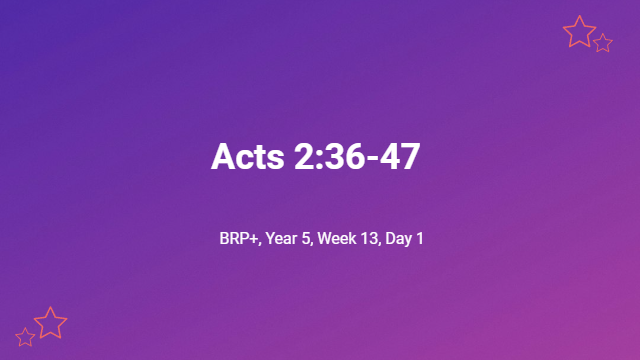Acts 2:36-47
Q.1. How did Peter conclude his Gospel presentation? How did the hearers respond? What was involved in the offer Peter made? – (Acts 2:36-38)
After furnishing supporting references from their Scriptures, Peter held them responsible for the crucifixion of Jesus. However, in keeping with – … the predetermined plan and foreknowledge of God, He declared… let all the house of Israel know for certain that God has made Him both Lord and Christ … (Acts 2:23 & 36). This had a dramatic effect upon the people – … they were pierced to the heart, and said to Peter and the rest of the apostles, “Brethren, what shall we do?” (Acts 2:37). Peter advised them to do two things to receive two things: “Repent, and each of you be baptized in the name of Jesus Christ for the forgiveness of your sins; and you will receive the gift of the Holy Spirit (Acts 2:37-38). They had to distance themselves from the rejection of their Messiah by the Jews and demonstrate this with action. It was extremely difficult and costly for a Jew to be baptized into any other belief since the traditional Jews prided themselves in having the truth (c.f. Rom.9:4-5; 10:1-4). However, forgiveness could only come to those who placed their trust in the merits of the Saviour. Receiving Christ meant that they would automatically – receive the gift of the Holy Spirit – as Jesus had promised (Acts 2:38 c.f. Jn.14:17-18, 23).
Q.2. How do we know that Peter’s Gospel appeal is timeless? What does real ‘conversion’ look like? To whom was baptism offered? – (Acts 2:39-41)
Christ’s mission was not only to Israel, but to the whole world (Mt.28:19-20; Jn.3:16; Acts 1:8). This promise was for all people for all times – For the promise is for you and your children and for all who are far off, as many as the Lord our God will call to Himself.” (Acts 2:39 c.f. Eph.2:11-18). Peter was clear in his demand that these respondents should change and stand out from the crooked generation of whom they were a part. (Acts 2:40). This expectation has not changed. Those who received this convicting message of their guilt and sin … the message declaring Jesus as Lord and Saviour, were baptized that very day (Acts 2:41). There was a harvest of some 3,000 souls of believers.
Q.3. How did the church follow up the CONVERTS? What did each activity add to the growth of the believers? – (Acts 2:42 c.f. 1:14; 1 Cor.11:26; Eph.2:20; )
The converts had a new direction and purpose – they were continually devoting themselves to the apostles’ teaching and to fellowship, to the breaking of bread and to prayer (Acts 2:42). The church became a devoted community. The apostles passed on the Scriptures that undergirded the Gospel, which had been entrusted to them by Jesus Christ (Lk.24:25-27, 44-48 c.f. Eph.2:20). They did not neglect the centrality of the death, burial, and resurrection of Christ, through the regular breaking of bread. They bathed their activities in prayer. They were dependent upon the risen Christ, and on one another.
Q.4. What changes were evident? Did the early church abandon their attachment to Judaism? How did God show His approval of the church? – (Acts 2:43-47 c.f. Jn.13:34-35)
God confirmed the authority of the Gospel, proclaimed by the apostles, with accompanying signs and wonders in the beginning (Acts 2:43 c.f. Heb.2:3-4). So great was their love and their oneness, that they shared their property and possessions (Acts 2:44-45). These early believers did not abandon their Jewishness but added home fellowship to the worship associated with the temple (Acts 2:46 & 42). Initially they had favour with the people. God showed His approval by – … adding to their number day by day those who were being saved (Acts 2:47).

